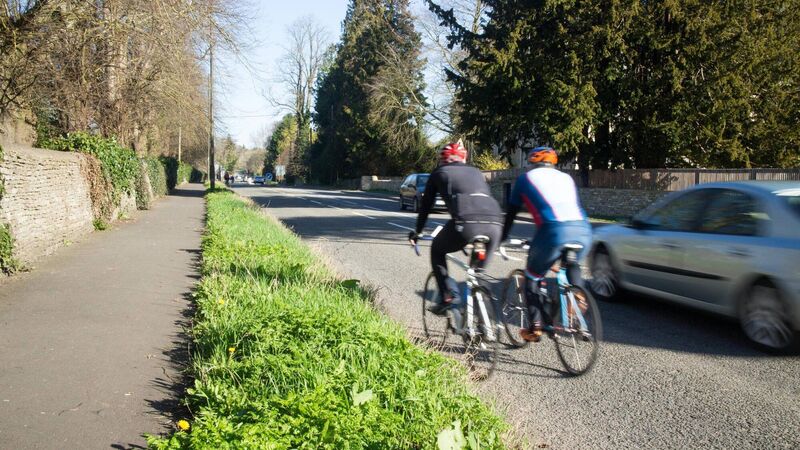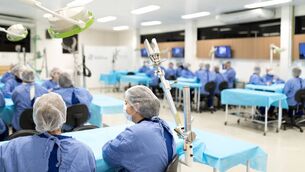Secret Cyclist: We're not 'freeloaders or rule-breakers' — We have a right to bear bikes

Often a point of contention between drivers and cyclists, riding 2 abreast is advised, except on narrow or busy roads or around bends.
Regular readers of this column will be aware that I have a strong desire to see more people cycling on this island. My reasons for this are both selfish and altruistic. The act of cycling a bike sparks joy and I would whole-heartedly like to see more people experience the joys of cycling. Equally, the more people who cycle, the better it becomes for those of us who already cycle.
Cycling differs from many other modes of transport, sports, and many leisure pursuits in this respect. Most people driving would like to see fewer and not more cars on the roads. I’d imagine that the typical GAA or soccer player in Ireland isn’t too concerned with the number of people who play their sport. There’s even a whole bunch of leisure pursuits like hillwalking that people do in order not to see other people.
I’d be delighted to see more people cycling alongside me when I’m going to work. There’s a higher chance that one of them will ask the council to sweep the cycle lanes more often or that someone might report a vehicle parked illegally across a cycle path. On dark winter mornings, it would be nice to have more company along the greenways too.
Sport and leisure cycling would also benefit from more people cycling. There would be more sportive events and who knows, the Indoor Velodrome project might even start construction. More people cycling means also more families and communities connected to cyclists. Hopefully, this would reduce the volume of negative and hostile feelings that many people have towards cycling and cyclists.
These feelings of negativity and hostility are often stifling discussion and debates about cycling in Ireland. Social media may not be a true barometer of public feeling but there’s a strong culture-war vibe regarding cycling on many platforms. Every news update about anything cycling-related seems to revert to first principles in the online comments section; "Why don’t cyclists follow the rules?", "Why are we spending money on these freeloaders?", "Why are they cycling two-abreast?", and so forth.
I’m a firm believer in education, which is good news as I’m paid a salary by the Department of Education. Seriously though, I would love to see educational programmes and campaigns about cycling. If we want to become a bike-friendly nation, it’s not enough to just ask civil engineers to build more cycle paths and then for us all to sit back and wait. The biggest cycle project that should be taking place in Ireland right now is one that constructs a new narrative about cycling.
How can we create this new narrative about cycling? One way is to look to the past. I’ve lost times the number of times someone has confessed to me "I cycled everywhere when I was younger." It turns out that despite all the talk online and the lamenting about our climate and hills, Ireland once had very strong levels of cycling. In 1944, the Lord Mayor of Dublin, Martin O’Sullivan, called Dublin the "most cycle-minded city in Europe." In fact, cycling made up a whopping 27% of all traffic in Dublin in 1961.
Similarly, the Connaught Sentinel reported in the 1950s that "every Saturday, bicycles line the kerbs between Eyre Square and Mainguard Street and are packed so closely together that it is often difficult to find a place where one might step off or onto the footpath. Dipping into the past can show us that our cities were once places where cycling was a normal way to get around and not the purview of idiosyncratic reckless hobbyists.
Looking into the past can show us that the solutions to making cycling more attractive aren’t radical. They’ve often been right in front of us for many years. In June 1999, the City Tribune newspaper in Galway reported that the Galway Cycling Campaign called for the introduction of a 20mph speed limit for certain roads in the city. Similarly, in 1995, Mark Crockett a Fianna Fáil Councillor called on Cork Corporation to create a cycle lane on Summerhill in Cork city to provide greater safety for cyclists. Neither of these suggestions has been fully realised, yet.
There are, fortunately, people out there trying to harness the wisdom and knowledge of the past to make the future of cycling brighter. As is often the case with cycling matters in Ireland, they do this in addition to their personal and professional commitments. Kevin Long is a volunteer with the Cork Cycling Campaign and he hopes to document the history of cycling in Cork over the past century, working in conjunction with the University of Eindhoven. He informed me that projects like this have been used in many cities to bring about the change in mindsets necessary to encourage more people to choose cycling
There are also people out there that have decades of knowledge and experience of what it feels like to cycle on our roads. Mike McKillen is a retired academic and the former chairperson of cyclist.ie, the Irish Cycling Advocacy Network. Mike cycled to work in Trinity College Dublin for 42 years. He feels that too many people in Ireland have a "windscreen view of traffic," and suggests that more officials, engineers, gardaí, and other stakeholders take to the bike to experience cycling.
Not a radical ask surely? They’d only be following in the footsteps of their parents and grandparents.






